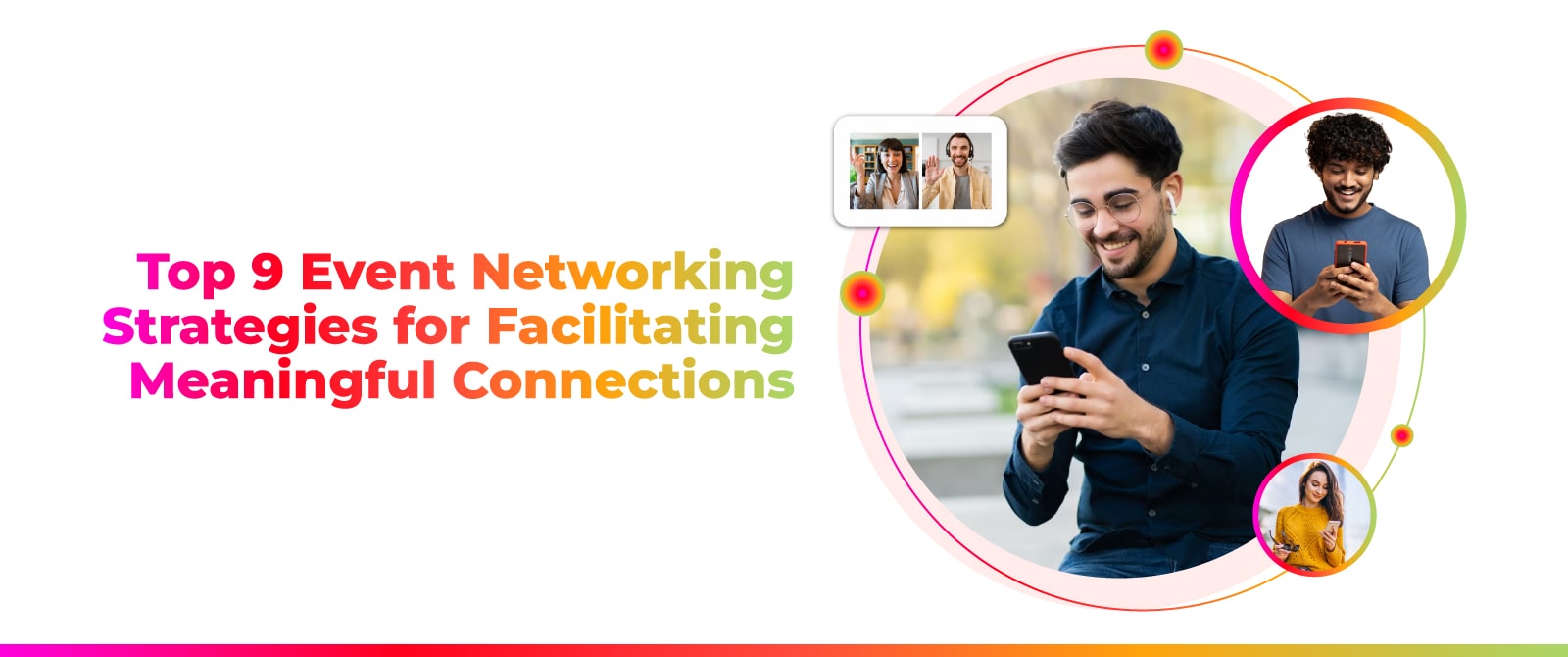Fostering genuine relationships among guests is critical for the success of any meeting in the shifting landscape of event organization. Event organizers now have amazing tools to increase participant engagement and build meaningful connections, thanks to the rise of event networking apps.
According to a study, Most professionals think making connections is important for their business, with 8 out of 10 saying it’s crucial. Almost everyone, about 99%, thinks that event networking helps create stronger and lasting relationships. And, surprisingly, 41% want to network more often
This blog looks at top event networking strategies that use technology to create a networking-friendly environment.
Strategies for Creating Long-Term Networking at Events

Strategy 1. Optimize Attendee Profiles: Make a Good First Impression Online
One of the best event networking strategies is optimizing attendee profiles. Developing an engaging digital presence begins with encouraging attendees to devote time and effort to creating detailed profiles on the event networking app. Attendees should be asked specific questions about their professional experience, areas of expertise, current initiatives, and hobbies. A fascinating bio that highlights their distinct traits and goals might serve as an exciting digital introduction.
These carefully produced profiles not only provide a picture of each member but also serve as important tools for attendees looking for meaningful relationships. Participants may more effectively discover possible connections by offering a full overview, ensuring that interactions throughout the event are not just random exchanges but deliberate engagements based on similar interests and aims.
Strategy 2. Strategic Icebreakers: Breaking Through the Digital Divide
Using the event networking app’s capabilities, organizers may incorporate interactive icebreaker elements aimed to break down digital boundaries and promote a sense of camaraderie among participants. These icebreakers may be creative and entertaining conversation starters or participatory activities that encourage players to strike up talks with other guests.
By including these aspects, event organizers create the tone for a welcoming and inclusive environment in which attendees feel more at ease reaching out to others. These event networking strategies serve as catalysts, igniting significant relationships and paving the way for more substantive discussions throughout the event.
Strategy 3. Targeted Networking Segmentation: Quality Over Quantity

Event organizers can use segmentation tactics inside the event networking app to improve the quality of networking connections. In addition, attendees can be divided into groups depending on their industry, interests, work positions, or other relevant characteristics. This segmentation enables organizers to arrange targeted networking sessions, ensuring that participants engage with people who have similar aims or are experiencing comparable issues.
Organizers may create a more focused and effective networking environment by highlighting quality over number, where contacts created during the event have a better possibility of growing into meaningful and sustainable professional partnerships.
Strategy 4. Scheduled Networking Sessions: Interaction with Structure
The inclusion of regular networking sessions directly into the event agenda creates an organized atmosphere in which relationships can grow. in addition, event organizers might set up specific time blocks for registrants to engage in concentrated networking activities. This event networking strategy not only keeps guests from becoming overwhelmed by the sheer variety of networking possibilities but also ensures that meaningful conversations occur.
These planned encounters, whether through speed networking, roundtable talks, or themed networking sessions, ensure that participants make the most of their networking opportunities, developing connections that go beyond surface introductions.
Strategy 5. Live Q&A and Discussion Forums: Encouraging Conversations

Integrating live Q&A sessions and discussion forums within the event networking app helps improve attendee participation. Additionally, this feature not only allows participants to interact with speakers and panelists, but it also encourages them to connect with other attendees. However, the open discourse enabled by live Q&A sessions and discussion forums fosters an environment in which people can share views, seek assistance, and interact based on common interests.
This dynamic interaction not only improves the overall event experience but also helps participants find common ground and participate in conversations that go beyond basic networking formalities.
Strategy 6. Gamification: Turning Networking into a Fun Challenge
By including gamification aspects in the event networking app for communities, networking may be transformed into a fun and engaging task. Organizers might assign points, badges, or awards for certain networking accomplishments, encouraging attendees to explore different aspects of the event and engage with a broad spectrum of guests. Gamification not only adds a pleasant competitive aspect, but also encourages participants to move beyond their comfort zones, resulting in more diverse and meaningful interactions.
Here are a few gamification ideas
- Achievement Badges: Award badges for completing networking milestones.
- Leaderboards: Create leaderboards based on networking activity levels.
- Networking Challenges: Encourage interaction with diverse professionals through challenges.
- Virtual Scavenger Hunts: Organize hunts to find specific professionals or resources.
- Interactive Quizzes: Host quizzes on industry topics for engagement.
- Networking Quests: Guide participants through themed networking tasks.
- Virtual Networking Bingo: Create bingo cards with networking-related tasks for rewards.
Strategy 7. Themed Networking Lounges: Creating Specialized Connection Spaces
The creation of themed networking lounges within an event venue or app allows attendees to meet in specific areas of interest. This event networking strategy gives tailored networking opportunities, whether they are focused on certain businesses, subjects, or career responsibilities. In addition, attendees with comparable professional backgrounds or interests can congregate in these designated lounges, encouraging deeper conversations and relationships within specific areas. Additionally, themed networking lounges enrich the networking experience by catering to the different interests of attendees.

Strategy 8. Virtual Business Card Exchange: Contact Sharing Made Simple
Streamlining the contact-sharing process is critical for ensuring that contacts created at the event may readily transfer into genuine professional ties. The event networking app‘s digital business card exchange function facilitates this procedure. Additionally, participants may easily share their contact information, making it easy for others to interact with them after the event. In addition, this digital exchange increases the possibility of subsequent contacts and partnerships by reducing communication obstacles. The simplicity with which virtual business cards may be exchanged guarantees that key contacts created during the event can be smoothly transitioned into ongoing professional partnerships.
Strategy 9. After-Event Engagement: Maintaining Connections Outside of the Venue
Event organizers may encourage attendees to stay engaged after the event by offering a platform for continued conversations through the app. Following the event, post-event interaction elements such as discussion boards, group chats, and collaborative spaces allow guests to continue forming relationships and explore future partnerships. However, this persistent involvement guarantees that the event’s influence on professional networks lasts, transforming initial contacts created during the event into long-lasting ties that reach beyond the venue’s walls.
Conclusion
Event networking apps have transformed how people communicate and create connections in the digital age. In addition, attendees may establish a networking environment that encourages lasting relationships by deliberately utilizing these technologies, adding substantial value to the entire event experience. Whether through optimized profiles, planned networking sessions, or post-event involvement, the aim is to facilitate encounters that go beyond surface-level discussions, ensuring that every connection formed is a step toward developing a strong professional network.
FAQs
Event networking is essential for professionals because it allows them to interact with people in the field, exchange ideas, and create vital contacts that may help them advance in their careers.
Connect with guests before, during, and after the event by using event networking applications and social media platforms. These platforms frequently allow users to arrange meetings, participate in pertinent discussions, and remain up to current on event events.
Send individual follow-up emails expressing your gratitude for the connection using the event networking app. To strengthen the link, refer to specific topics or subjects from the event. Stay involved by engaging in professional networks and checking in regularly to cultivate the connection.
You may use the event networking app’s analytic capabilities to track the success of your event networking activities. These tools provide information on indicators including the number of connections formed, engagement levels, and profile reach. Analyzing this data allows you to evaluate the performance of your event networking strategies and make changes for future events.






